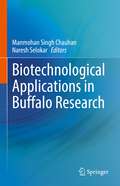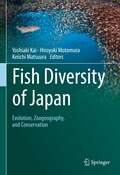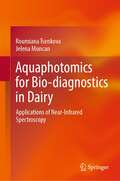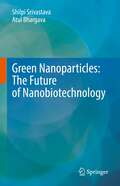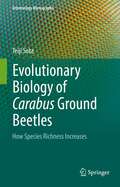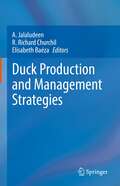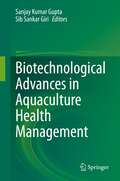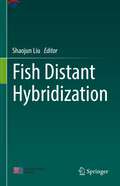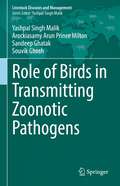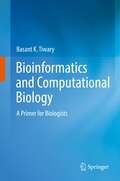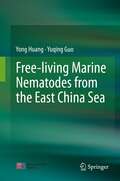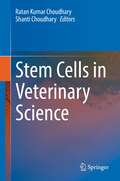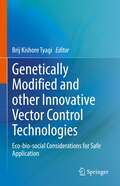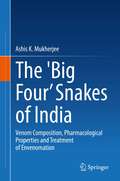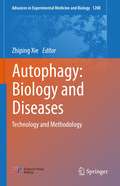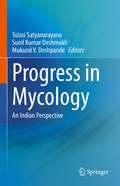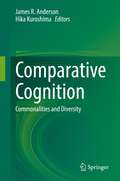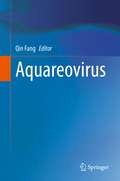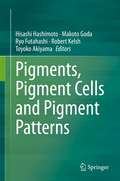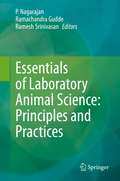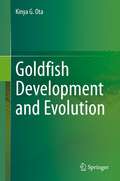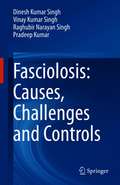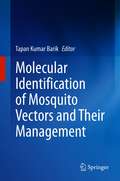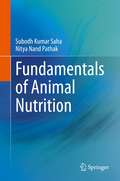- Table View
- List View
Current Thoughts on Dementia: From Risk Factors to Therapeutic Interventions
by Ghulam Md Ashraf Md. Sahab UddinThis informative book discusses the latest research on the risk factors and therapeutics in dementia. WHO calls dementia a public health priority. Dementia manifests as a group of symptoms associated with decline in memory or other thinking skills and is severe enough to reduce a person's ability to perform everyday activities. It occurs frequently among elderly people, but it is not necessarily part of the normal aging process. The book has been divided into two broad sections. The first section reviews the risk factors involved in developing dementia, including various medical conditions, lifestyle choices, as well as genetics. The latter section describes various therapeutic interventions in dementia. Although there is no known cure for dementia, this book underlines the current treatment strategies that could momentarily reduce the symptoms and improve the quality of life of the patients. This book highlights the global effort to find better ways to halt the progression of dementia and develop novel therapeutic strategies. The book would be an interesting read for advanced graduate students and researchers working in the field of neuroscience, genetics, and medicine. It will generate good interest to neurologists, psychiatrists, geriatricians, cardiologists, internal medicine practitioners, epidemiologist, and public health workers.
Biotechnological Applications in Buffalo Research
by Manmohan Singh Chauhan Naresh SelokarThis book comprehensively reviews the advancements in biotechnological applications for the enhanced production and conservations of buffalo (Bubalus bubalis). The book discusses developments in assisted reproduction to improve productivity and the produce novel products for applications to human health and nutrition. The initial chapters of the book discuss the global distribution and domestications of buffalo, and nutritive values of buffalo milk, while the subsequent sections examine the applications of the genome-wide association traits to identify potential genetic variants affecting important economic traits. It identifies predictive biomarkers for postpartum or peripartum diseased-state and presents potential protein biomarkers for the diagnosis of early pregnancy in buffalo. Lastly, it discusses recent scientific developments such as induced pluripotent stem cells, spermatogonial stem cells, somatic cell nuclear transfer, and buffalo as a model for human biomedical research. This book is a useful source to students, academicians, researchers, and policymakers who are involved in buffalo science and industry.
Fish Diversity of Japan: Evolution, Zoogeography, and Conservation
by Yoshiaki Kai Hiroyuki Motomura Keiichi MatsuuraThis book reviews and summarizes the studies on the fish diversity of Japan. It covers the present knowledge of ichthyofauna, habitat distribution, phylogeography, ecology, morphology, and conservation, as well as the history of ichthyology and fish collections in Japan. The book comprises five parts: I. Fish Diversity and Ichthyology of Japan, II. Habitat Distribution and Species Diversity, III. Diversity within Species: Phylogeographic Perspective on Japanese Fishes, IV. Morphological and Ecological Diversifications, and V. Conservation of Fish Diversity in Japan. The Japanese Archipelago is surrounded by two major warm and one cold currents. It is located in the western North Pacific and encompasses several climatic regimes from north to south. Although the land area of Japan is small, the Exclusive Economic Zone (EEZ) of Japan ranks as the sixth largest in the world, including several marginal seas (Sea of Okhotsk, Sea of Japan, and East China Sea), and deep trenches (Izu-Ogasawara, Japan, and Kurile Trenches). Owing to a variety of marine habitats and a complex geological history, Japan has a rich fish species diversity, representing over 4,500 species in 370 families. The richness of fish species diversity has attracted many scientists since the late 1700s, and continuous studies have led to the development of ichthyology in Japan. With chapters written by leading experts in the field, the book will provide a stimulating and reliable resource for future research and contribute to the progress of ichthyology of the world.
Aquaphotomics for Bio-diagnostics in Dairy: Applications of Near-Infrared Spectroscopy
by Roumiana Tsenkova Jelena MuncanThis book is the result of more than 20 years of experience in working with near-infrared spectroscopy for raw milk analysis. The totality of this work presents extensive possibilities for milk spectral measurements that can be carried out in dairy. Moving beyond the standard milk components such as fat, protein, or lactose, this book presents near-infrared spectroscopy as a method that can also be used in disease diagnostics. The measurements and experimental results presented here are all based on the utilization of usually neglected near-infrared regions—regions with strong absorbance of water. The author has found the water – light interaction discussed to be an immensely rich source of information, not only on milk composition but also on the physiological status of the animals involved. A special section of the book is dedicated to exploration of potential interfering factors that may influence the analysis and contribute to the robustness of the models. The research described in this book served as a basis for the development of the novel discipline aquaphotomics and is of interest to anyone working in this field.
Green Nanoparticles: The Future of Nanobiotechnology
by Shilpi Srivastava Atul BhargavaThis book discusses the fundamental concepts of the green synthesis of nanoparticles and presents the latest advances in this emerging field. Providing a comprehensive overview of developments related to nanoparticle synthesis using fungi, algae, bryophytes, pteridophytes, gymnosperms, monocotyledons, dicotyledonous (angiosperms) and animal systems, it also explores techniques for the characterization of these nanoparticles. Lastly, it reviews the applications and toxicity of biologically synthesized green nanoparticles. Given its scope, it is a valuable resource for students, researchers and policymakers working in the field of nanobiotechnology and nanoscience.
Evolutionary Biology of Carabus Ground Beetles: How Species Richness Increases (Entomology Monographs)
by Teiji SotaThis book presents the whole picture of the ecological and evolutionary study on the ground beetle group, the subgenus Ohomopterus of the genus Carabus, endemic to Japan. This flightless beetle group consists of many geographic races. They show divergence in key traits for reproductive isolation—body size and genital morphology, which leads to coexistence of two or more species. This beetle group provides an important material to study how a lineage of organisms diversify and form multi-species assemblage, and thereby multiply their species richness. The book introduces novel genomic approaches to resolve questions about evolution of Ohomopterus. The readers will find that this story of evolution in Carabus beetles revealed by recent approaches is much different from what was told in previous literature.Exploring different cases across a wide range of lineages is important in constructing a synthetic theory of species radiation and richness, including speciation and species coexistence. This study on Ohomopterus beetles contributes to the ongoing discussion to understand how and why species multiply and how species richness increases in one area of our planet.
Duck Production and Management Strategies
by A. Jalaludeen R. Richard Churchil Elisabeth BaézaThis book provides comprehensive insights into the field of duck production and management. It presents a complete overview of different aspects of duck production with particular emphasis on rearing systems. The book reviews current knowledge on the anatomy, physiology, genetics, breeding, nutrition, incubation, and hatching practices of ducks. It further discusses the common diseases of duck, their treatment regime, and prevention strategies. The book additionally examines all aspects of the global duck industry, the constraints, and the recommendations. It also explores nutrient requirements and feed evaluation for duck and evaluates nutrition's influence on the gut microbiome. Towards the end, the book presents the latest genomic applications, including high throughput sequencing and various bioinformatics tools in duck production. This book serves as an essential resource for duck industry practitioners, researchers, and students.
Biotechnological Advances in Aquaculture Health Management
by Sanjay Kumar Gupta Sib Sankar GiriThis book is an inclusive coverage of advances in aquaculture health management. It offers latest updates as well as explains the novel concepts and issues related to aquatic animal health management. To support the understanding of the concepts, there is extensive use of illustrations. Chapters emphasize on the state of art techniques and hold great promise for the sustainable development of aquaculture. This book is of interest to teachers, researchers, aquatic biologists, capacity builders and policymakers. Also the book serves as additional reading material for undergraduate and graduate students of aquatic sciences, marine sciences, biotechnology, ecology, and environmental sciences. National and international aquatic scientists, policy makers will also find this to be a useful read.
Fish Distant Hybridization
by Shaojun LiuThe book introduces fish distant hybridization, which covers the basic theory and applications of fish distant hybridization as well as the main biological characteristics of different ploidy fish at the individual, tissue, cell, and molecular level. It is divided into 12 Chapters. The research progresses of animal distant hybridization and polyploids in domestic and overseas are summarized in this book. The characteristics of these hybrids and polyploid fish are also illustrated on basis of considering factors of the chromosomes numbers, phylogenetic relationship, reproduction, appearance, feeding habits, growth rate, and stress resistance. The creation of fish distant hybridization lineages will provide a clear genetic background which is helpful for the study of the strain generation as a model in genetic variation characteristics and reproductive characteristics. Fully illustrated in color, this book provides unique ideas in system description and presentation of distant hybridization and polyploidy fish. In fish genetic breeding, the tetraploid fish lineage and diploid fish lineage, formed through distant hybridization, can be used for preparing large-scale triploid and diploid fish. This book is a useful reference for researchers in fish genetic breeding, aquaculture, developmental biology, and animal evolution, and serves as a valuable resource for students and researchers engaging in zoology, evolutionary biology, and genetics.
Role of Birds in Transmitting Zoonotic Pathogens (Livestock Diseases and Management)
by Yashpal Singh Malik Arockiasamy Arun Prince Milton Sandeep Ghatak Souvik GhoshZoonotic diseases pose a serious threat to global health and economy. Domestic and wild birds play crucial roles in transmission and spread of important zoonotic pathogens, with significant implications on human and avian health. Although zoonotic diseases have been extensively studied, information on various aspects of avian zoonotic pathogens have not been revisited or revised to any great extent. This book is a comprehensive and updated compilation of important zoonotic diseases that are transmitted by domestic and wild birds, and consists of 21 chapters that meticulously describe the (i) etiology and evolution, (ii) complex epidemiology, such as migration pathways in context of disease transmission, (iii) pathogenesis, (iv) clinical signs and necropsy findings, (v) diagnostics including latest molecular assays, and (vi) preventative and control strategies, with an emphasis on therapeutics and prophylaxis, of important zoonotic pathogens (bacterial, fungal, parasitic and viral) of avian origin in humans and birds. Each chapter is aptly supported by interactive tables and figures, and features an updated reference section. This book aims to create awareness and enlighten students of veterinary and human medicine on the role of birds in zoonoses, and would serve as a useful reference for working veterinarians, human doctors, and public health experts.
Bioinformatics and Computational Biology: A Primer for Biologists
by Basant K. TiwaryThis textbook introduces fundamental concepts of bioinformatics and computational biology to the students and researchers in biology, medicine, veterinary science, agriculture, and bioengineering . The respective chapters provide detailed information on biological databases, sequence alignment, molecular evolution, next-generation sequencing, systems biology, and statistical computing using R. The book also presents a case-based discussion on clinical, veterinary, agricultural bioinformatics, and computational bioengineering for application-based learning in the respective fields. Further, it offers readers guidance on reconstructing and analysing biological networks and highlights computational methods used in systems medicine and genome-wide association mapping of diseases. Given its scope, this textbook offers an essential introductory book on bioinformatics and computational biology for undergraduate and graduate students in the life sciences, botany, zoology, physiology, biotechnology, bioinformatics, and genomic science as well as systems biology, bioengineering and the agricultural, and veterinary sciences.
Free-living Marine Nematodes from the East China Sea
by Yong Huang Yuqing GuoThis book describes and illustrates 300 species of free-living marine nematodes from the East China Sea and includes eighteen new species. Free-living marine nematode is the most dominant and diverse meiofaunal group in marine benthic habitats. It has strong adaptability and wide distribution, and plays a very important role in the material circulation and energy flow of benthic ecosystem. Up to now, about 7,000 species of free-living marine forms (attached to 2 Class, 8 Order, 86 Family, 662 genera) have been recorded around the world. Some 500 species have so far been reported from the sea areas of China. Among them, more than 300 species were identified from the East China Sea. The book will provide basic data and information of free-living marine nematodes for ecosystem management, protection and utilization of marine biological resources in the East China Sea.
Stem Cells in Veterinary Science
by Ratan Kumar Choudhary Shanti ChoudharyThis book explores the potential applications of animal stem cells in veterinary medicine. It begins with an overview of stem cells and their application in treating various animal diseases, including mastitis. In turn, the book discusses the challenges of using stem cells in regenerative medicine and emphasizes the importance of understanding the action of stem cells and preclinical evidence for ensuring safety and therapeutic efficacy. It also presents methods for the identification, characterization, and quantification of stem cells. Further, it discusses the therapeutic applications of different stem cells, including milk-derived, testicular, and mesenchymal stem cells in veterinary medicine. Lastly, it discusses strategies for and therapeutic applications of genome editing by CRISPER/Cas9 in mammary stem cells. As such, the book offers a valuable resource for students and scientists working in the veterinary sciences and veterinarians.
Genetically Modified and other Innovative Vector Control Technologies: Eco-bio-social Considerations for Safe Application
by Brij Kishore TyagiThis book comprehensively covers the latest development in developing and deploying the genetically modified vectors, particularly Anopheles and Aedes mosquitoes responsible for transmitting malaria parasites and dengue viruses, the most deadly and/or debilitating among all the vector-borne diseases. It is considered timely and commensurate to bring about a book dealing with the various ecological, biological and social as well as regulatory aspects for the deployment of genetically modified vectors in special context with the biosafety of humans, his associates, and the environment. Written by an array of specialists and experts in various subjects of genetically modified organisms, this book centrally addresses the (i) basic principles of the genetic manipulation of vectors and they are potential impact on human and the environment, (ii) ecological, biological, ethical, legal and social implications of the use of genetically modified vectors, (iii) identification of potential hazards; assessment and management of risks for human and environment; risk/benefit analysis, (iv) principles and practices for the assessment and management of biosecurity and biosafety in laboratories (and in the field), (v) guiding principles for creation and management of institutional or national biosafety review boards and ethics review committees, and (vi) development and application of a biosafety regulatory framework and its related legal principles at national levels for securing the development and use of vector control methods based on genetic modification strategies. This publication will be useful to researchers, scientists, and professionals engaged in academic and research institutions, government or non-government, as well as students in universities and medical colleges.
The 'Big Four’ Snakes of India: Venom Composition, Pharmacological Properties and Treatment of Envenomation
by Ashis K. MukherjeeThis book provides detailed and updated knowledge about medically important ‘Big Four’ venomous snakes of India (Indian spectacled cobra, Indian common krait, Indian Russell’s viper, and Indian saw-scaled viper). This book essentially covers the snakebite problem in the world with particular reference to Asia and India. It discusses the evolution and systematics of venomous snakes, emphasizing ‘Big Four’ venomous snakes of India; the evolution and composition of venoms determined by traditional biochemical and modern proteomic analyses. It also describes the pharmacological properties of enzymatic and non-enzymatic toxins of ‘Big Four’ venomous snakes of India. Different chapters discuss exciting topics such as species-specific and geographical differences in venom composition and its impact on pathophysiology and clinical manifestations of snakebite envenomation in India, biomedical application of Indian snake venom toxins; production and quality assessment of commercial antivenom, prevention, and treatment of snakebite in India, adverse effects of antivenom including strategies to combat antivenom reactions inpatient.This book caters to toxinologists, pharmacologists, zoologists, antivenom manufacturers, biochemists, clinicians, evolutionary biologists, herpetologists, and informed non-specialists interested to know about the Indian snake venoms.
Autophagy: Technology and Methodology (Advances in Experimental Medicine and Biology #1208)
by Zhiping XieThis book series consists of 3 volumes covering the basic science (Volume 1), clinical science (Volume 2) and the technology and methodology (Volume 3) of autophagy. Volume 3 focuses on the technical aspects of autophagy research. It is comprised of two parts. The first part discusses the basic process of autophagy, including its overall classification and individual stages in the life cycle of autophagosomes. The second part discusses the tools, strategies, and model systems in current autophagy research, including cell and animal models, detection and manipulation methods, as well as screening, genomic, proteomic and bioinformatic approaches. The book is written and edited by a team of active scientists. It is intended as a practical reference resource for interested researchers to get started on autophagy studies.
Progress in Mycology: An Indian Perspective
by Tulasi Satyanarayana Sunil Kumar Deshmukh Mukund V. DeshpandeIndian mycologists have extensively studied various groups of fungi such as soil fungi, aquatic fungi, marine fungi, endophytic fungi, fungi associated with man and animals. Though several books on various aspects of fungi are published, this is the first account of the history and developments in mycology in India. It discusses at length various stages of development of mycology including both classical and biotechnological aspects. It begins with a historical account of Indian mycology, followed by a description of research on fossil fungi. Further chapters cover the latest updates on different taxonomic groups of fungi. A dedicated section describes the roles and applications of fungal endophytes. The book also includes research in other important areas such as mushrooms and wood rotting fungi. Different chapters are written by leading mycologists. This book is useful to students, teachers and researchers in botany, microbiology, biotechnology and life sciences, agriculture and industries using fungi to produce various valuable products.
Comparative Cognition: Commonalities and Diversity
by James R. Anderson Hika KuroshimaThis book presents an overview of selected topics in comparative cognition, which is the study of behaviour and mental activities in nonhuman animals. Human psychological capacities are often used as a heuristic by comparative cognitive scientists, whose tasks include designing valid procedures for studying species’ sensory, linguistic or manipulatory abilities that differ from those of humans. Nonetheless, researchers have developed many original ways to gain insights into how other species perceive the world, store and integrate information, and communicate. The contributors to this book have all been involved in such work, and will present some of the approaches that have led to clear advances in our understanding of cognitive processes in other species. The chapters integrate a review of past literature with recent work, covering a variety of subject species including birds, domestic dogs and cats, and nonhuman primates. All contributors have worked with or been otherwise influenced by Professor Kazuo Fujita, to whom the volume will be dedicated. Fujita’s openness to research on various topics and species is reflected in the diversity of the chapters presented.The book will be of interest to students and more experienced researchers in diverse fields including psychology, anthropology, biology and veterinary studies.
Aquareovirus
by Qin FangAquareoviruses cause infection in bony fish and shellfish and thus, constitute a significant threat to aquaculture industries worldwide. Aquareoviruses, belonging to the family Reoviridae, have genomes consisting of 11 segments of double-stranded RNA contained within a core (T = 1) surrounded by a double-layered icosahedral capsid with a T = 13 symmetry in general. These viruses not only physically resemble mammalian orthoreoviruses, but also show the highest amino acid identity. More than hundred aquareoviruses have been isolated from both saline water and freshwater origins; however, literary sources elucidating aquareovirus biology are very limited. Given the increasing pace of discovery, it is imperative to make a clear, systematic filing of key aspects of aquareoviruses. Therefore, the aim of writing this book is to provide insights into the molecular mechanisms of evolution, pathogenesis, and host response in aquareovirus infection. This book offers a state-of-the-art report on recent discoveries concerning the aquareovirus genome evolution, gene encoded protein functions, and pathogenesis by comparison with its sister genus Orthoreovirus, including avian and mammalian reoviruses. It mainly focuses on advances made over the past 30 years in research on the general and molecular biology, protein structure and function, infection and replication, epidemiology and diagnosis, immunological prevention and medical treatment, and host antiviral immunity against aquareovirus infection. This book will help curious graduate students or interested researchers acquire an overall picture of aquareovirus infection and pathogenesis, as well as yield benefits in fisheries to better prevent and control diseases caused by aquareovirus infection.
Pigments, Pigment Cells and Pigment Patterns
by Hisashi Hashimoto Makoto Goda Ryo Futahashi Robert Kelsh Toyoko AkiyamaThis book comprehensively summarizes the biological mechanisms of coloration and pattern formation of animals at molecular and cellular level, offering up-to-date knowledge derived from remarkable progress in the last 10 years. The brilliant coloration, conspicuous patterns and spectacular color changes displayed by some vertebrates and invertebrates are generally their strategies of the utmost importance for survival. Consists of mainly three parts, starts with introductory chapter, such as Pigments and Pigment Organelles, Developmental Genetics of Pigment Cell Formation, Adult Pigment Patterns, and Color Changes, this book introduces new pigment compounds in addition to classically known pigments and organelles, explains how the generation of multiple types of pigment cell is genetically controlled, describes the mechanisms underlying the zebrafish stripe formation as well as other animals and also summarizes the mechanism of physiological and morphological color changes of teleost, amphibian and cephalopod. Written by experts in the field, this book will be essential reading for graduate students and researchers in biological fields who are interested in pigmentation mechanisms of animals.
Essentials of Laboratory Animal Science: Principles and Practices
by P. Nagarajan Ramachandra Gudde Ramesh SrinivasanThis book comprehensively reviews the anatomy, physiology, genetics and pathology of laboratory animals as well as the principles and practices of using laboratory animals for biomedical research.It covers the design of buildings used for laboratory animals, quality control of laboratory animals, and toxicology, and discusses various animal models used for human diseases. It also highlights aspects, such as handling and restraint and administration of drugs, as well as breeding and feeding of laboratory animals, and provides guidelines for developing meaningful experiments using laboratory animals.Further, the book discusses various alternatives to animal experiments for drug and chemical testing, including their advantages over the current approaches. Lastly, it examines the potential effect of harmful pathogens on the physiology of laboratory animals and discusses the state of art in in vivo imaging techniques.The book is a useful resource for research scientists, laboratory animal veterinarians, and students of laboratory animal medicine.
Goldfish Development and Evolution
by Kinya G. OtaThis book explains how the beautiful goldfish body develops from a single fertilized egg and how this developmental process was changed during the process of domestication. The contents can be categorized as follows: i) numerous high-quality live photo images of embryonic and larval stage goldfish, ii) detailed descriptions of skeletogenesis with fluorescent microscopic and histological images, iii) the most advanced interpretation of the relationship between artificial selection and developmental processes, iv) future perspectives of the application of the genome editing techniques for the ornamental goldfish breeding, and v) methodological descriptions for goldfish developmental biology. Goldfish is a popular ornamental domesticated fish species, and its highly diverged morphological features and color variations attract fanciers. The goldfish has been spread all over the world by breeders, and this fish has also been employed as an experimental organism by researchers in the field of life science. However, so far, no available scientific books provide a detailed description of the embryogenesis and morphogenesis of this animal. Compared with the number of published fancier books, the number of books on goldfish biology is very few. This publication will be useful not only for the research community particularly in the fields of developmental biology, evolutionary biology, zoology, aquaculture, fishery science, and related areas but also for enthusiastic goldfish fanciers and breeders.
Fasciolosis: Causes, Challenges and Controls
by Dinesh Kumar Singh Vinay Kumar Singh Raghubir Narayan Singh Pradeep KumarThis book provides an up-to-date review of fasciolosis, a disease caused by Fasciola hepatica and Fasciola gigantica, including its biology, transmission, epidemiology, host distribution, economic impact, and novel approaches for its diagnosis, treatment and prevention.It first offers a brief overview of the history of the disease, the genetic diversity of the parasite and its distribution, and the ecology of the vector snail, which belongs to the Lymnaeidae/Planorbidae family. It also examines the current strategies and novel approaches for controlling the parasite, diagnosing infections and vaccine development.Importantly, it highlights issues relating to the control of fasciolosis, including drug resistance, lack of effective diagnostics, and the parasite’s long-term survival strategies based on regulation and modulation of the host immune system. Lastly, it discusses the novel control snail vectors using bait formulations, and synergetic and phototherapy treatment with chlorophyllin, which does not kill the vector.
Molecular Identification of Mosquito Vectors and Their Management
by Tapan Kumar BarikThis book summarizes the recent advancements in identifying the mosquito vectors and discusses various strategies for their control. The book describes various molecular taxonomic methods, including DNA barcoding and single nucleotide polymorphism-based machine learning approach, which are used for the identification of mosquito vectors. It also presents the various mosquito control methods, namely, phytochemicals, Bacillus thuringiensis toxins, nanotechnology, biological control agents, and environmental management strategies. It also highlights the importance of various repellents that are used for protection from different kinds of mosquito vectors. Finally, the book offers a comprehensive yet representative description of challenges associated with mosquito vector-borne diseases. The book is a useful resource for medical entomologists, health workers, and researchers working in mosquito-control and vector-borne diseases.
Fundamentals of Animal Nutrition
by Subodh Kumar Saha Nitya Nand PathakThe book provides comprehensive information about the different aspects of veterinary nutrition in tropical countries.The introductory chapter discuss the importance of nutrition, feeds and feeding of balanced and optimum feeds specifically required for the sustenance of life. The second chapter, discusses briefly the history of research in animal nutrition.The book further talks about the relationship between the environment and nutrition in animals; the chemical composition of plants and animals; and the various sources of feed for animals. It provides details on the different phases of life cycle in animals, and the effect of nutrition on the performance. Various Nutrients and its importance in livestock nutritionand production has been illustrated in details. Various nutrients such as water, carbohydrate, protein, fats, vitamins, minerals etc are individually dealt in a separate chapter. The digestive system,digestion and metabolism of carbohydrates, protein and fats in ruminant and non ruminant livestock have been illustrated. A dedicated chapter fully describes the activity of enzymes which are directly involved in nutrition. Also this book deals with the harmful components of animal feed which are found mainly in the unconventional feeds. The books also provide chapters like partitioning of feed& energy and also the therapeutic and clinical nutrition which are very importantfor the under graduate & post graduate students and researchers of animal nutrition and livestock production and management. This book is useful for researchers, undergraduate and post graduate students studying veterinary sciences, animal husbandry, zoology and biochemistry.

